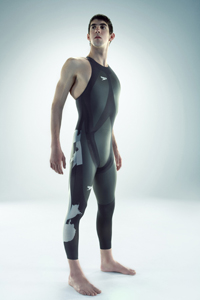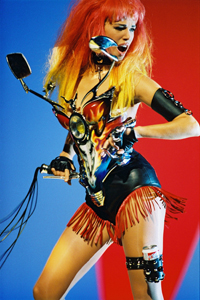During
a recent trip to New York City, I had the chance to visit The
Metropolitan Museum of Art. While there, I took the opportunity to
visit The Costume Institute's Superheroes Fashion and Fantasy
exhibit. Expecting to see original movie and television show costumes
once worn by various celebrities, I soon found out that this exhibit
hosts much more. In fact Superheroes Fashion and Fantasy is about
much more than superhero costumes. The exhibit is about high art
fashion inspired by superhero costumes, the concepts superheroes
project through their character, super powers and their costumes, and
the body's transformation when in a costume.
Upon
entering the Superheroes Fashion and Fantasy exhibit, visitors are
greeted by a ghosting Superman/Clark Kent figure, part of The Graphic
Body I, a portion of the exhibit devoted to iconography of branding.
Superman's “S” shield emblem plays a major role in this portion
of the exhibit, and Rosella Jardini, from the Moschino fashion company
plays on that, substituting the “S” emblem with an “M” for
Moschino. The Graphic Body I bridges comic books and fashion through
signs and logos which, as the exhibit posting notes, “serve to
ensure the body's passage into the field of the symbolic and
representational.
Moving
further into the exhibit brings you to The Graphic Body II, featuring
Spider-Man and the iconography of the webbed costume and the spider
symbol, featuring Tobey Maguire's costume
from
Spider-Man
3.
What
better pieces of fashion to complement the Spider-Man costume than
those created by ski wear company Spyder, whose pieces often include
spiders or webbed printing, a deliberate reference to Spider-Man.
Also included are some various web themed dress designs from the
likes of Giorgio Armani,Thierry Mugler and Jean Paul Gaultier.
 Click image to enlarge - Photo courtesy of The MET
Click image to enlarge - Photo courtesy of The MET
Up
next, The Aerodynamic Body, featuring The Flash. This portion of the
exhibit is devoted to propulsion, speed and agility. Included in this
section are a number of pieces that have actually been used outside
of the world of the runway, and in real life sporting events, like
the Nike “Swift Suit” and Speedo's “Fast Skin”. One of the
designs has

Michael Phelps in LZR Racer.
|
actually been used by the Canadian speed skating team.
Other more interesting pieces took a different spin on aerodynamics,
like Hussein Chalayan's pink “Aeroplane Dress”, built out of
panels which look like airplane wings, or the experimental wing suits
by Altair.
Around
the corner, you'll find The Patriotic Body, which features the
costume worn by Lynda Carter in
Wonder
Woman
,
and a number of pieces inspired by the red, white and blue motif of
Wonder Woman's costume and the traditionally American aspects of
classic superheroes.
The
next portion, The Virile Body, is one of the most interesting parts
of the exhibit, not because of the costume that was picked for the
display, but because there was no possibility of picking a costume.
This is because The Virile Body was represented by The Incredible
Hulk, a character whose acted form has never, officially speaking,
had a real costume (no purple pants don't count). All of the pieces
in this portion of the exhibit focus on physical bulk, merely playing
off of The Hulk's massive form. There is a football uniform, an
inflatable body suit and a rather interesting, fetishistic piece by
designer John Galliano, which includes a hose-pipe phallus.
Further
in, you'll find The Paradoxical Body, featuring Catwoman. This
section includes both a remake of Michelle Pfeiffer's costume from
Batman
Returns
and
pieces inspired by Catwoman over the generations. The costumes, much
like a number of recent representations of the character, are very
much based in erotica, the dominatrix look and sadomasochistic
underpinnings. The cool thing about the different Catwoman costumes
over time though, is that you really get a glimpse into how the
fashion of the time inspired the Catwoman costume of that generation,
like the 70s look of the costume from the Adam West
Batman
television
series. It also appears that the costume has gotten more and more
revealing over time.
 Click image to enlarge -
Photo
courtesy of The MET
Click image to enlarge -
Photo
courtesy of The MET
Next
came my favourite part of the entire exhibit, The Armored Body. This
portion was actually split into two areas, one featuring
Batman
,
accompanied by both armored and dark, brooding fashion inspired by
the character, and
Iron
Man
,
surrounded by a number of “futuristic”/armored fashions,
including one particularly intriguing piece by Thierry Mugler, a
women's armor body suit with only the vulnerable areas exposed, an
inspired look at human frailty.
Between
the
Batman
and
Iron
Man
portions of this area, I find it very tough to decide which I liked
better. I found it awe inspiring to stand in front of Christian
Bale's costume from
The
Dark Knight,
behind which was a gigantic version of an Alex Ross work from
Batman:
War on Crime
,
with Batman looking down on Gotham City. At the same time, I found it
incredible to actually get to see Iron Man Mark 2 costume worn by
Robert Downey Jr., because it looks like an actual, usable suit. To
me, that's just mind blowing!
The
fashion pieces also accompanied both characters quite well. On the
Batman
side were a couple of pieces that looked like tactical wear, Kevlar
vests and all. The most interesting fashion piece from this side
though, was a dress (I think) by Gareth Pugh which looked like the
human version of a stealth fighter, including a face mask. While the
dress part itself is more of a regular mesh style, the arm pieces and
face mask have the very distinct shaping and tiling that make them
look like they could deflect radar.
 Click image to enlarge -
Photo
courtesy of The MET
Click image to enlarge -
Photo
courtesy of The MET
On
the
Iron
Man
side, the majority of the pieces were, to me, what looked like
classic representations of what clothing would look like in the
future. All of the pieces were very metallic, and looked as if the
wearer would be living in a world where they were constantly
protecting themselves from some form of radiation or other threat.
This includes the previously mentioned Mugler piece, but that one
breaks the mold of the protective look by exposing the vulnerable
areas of the body.

Photo: Patrice Stable
|
Finally,
the last two portions of the exhibit, The Mutant Body, inspired
largely by
X-Men,
and The Postmodern Body, represented by
Ghost
Rider
and
The
Punisher
,
have their own unique styles. The Mutant Body area wasn't very
captivating, as I found it very difficult to place any of the
particular styles of fashion to any mutant. One of the pieces did
remind me, somewhat, of the Vulture from
Spider-Man
,
but he's not actually a mutant. In The Postmodern Body though,
another Mugler piece, clearly inspired by
Ghost
Rider
,
was very eye catching. It's a motorcycle corset, and what's amazing
about this particular piece is that he just makes it look like he
took a motorcycle and turned it into clothing, as if he modified the
parts to fit the human form.
The
exhibit finally finishes off with a small collection of classic comic
books, including a print of
Action
Comics No. 1
,
placed securely behind thick glass. Superheroes Fashion and Fantasy
takes a very unique look at the world of superheroes in comic books,
film and television, and how they have inspired pop culture and
fashion. It's the kind of exhibit that is exciting, not just for
comic book enthusiasts, but for anyone into fashion or pop culture as
well. It is a must see if you're in New York City, especially if you
are a fan of Alex Ross' work. Seeing some of his works enlarged to as
much as 10 high is jaw dropping, and they complement the exhibit
beautifully. Superheroes Fashion and Fantasy is running at The
Metropolitan Museum of Art in New York City until September 1
st
.